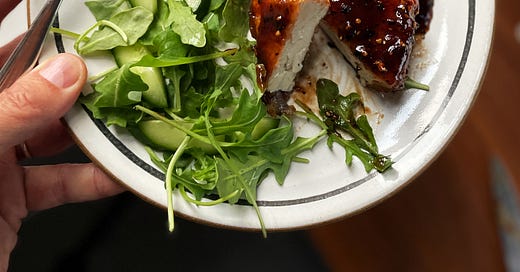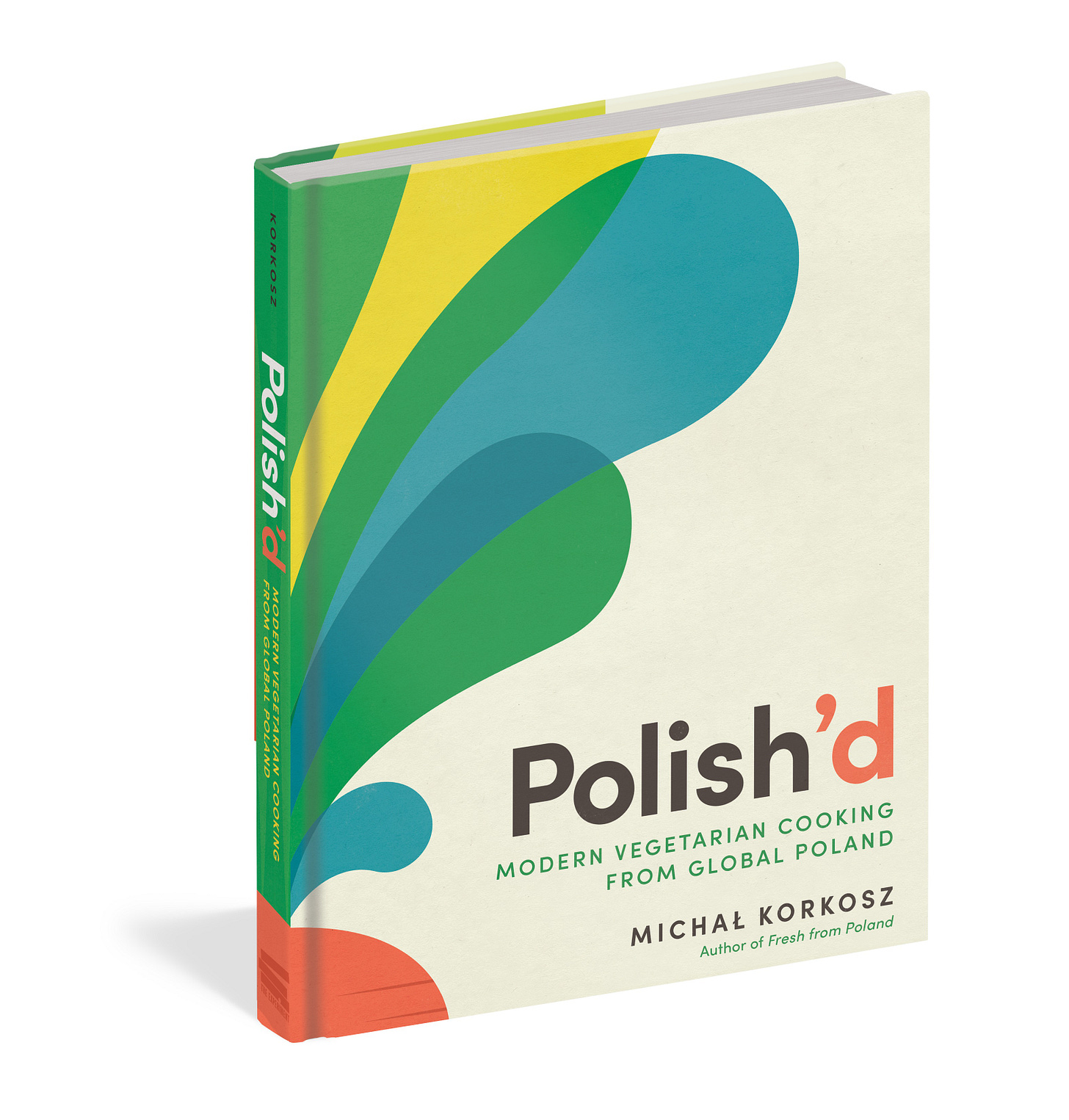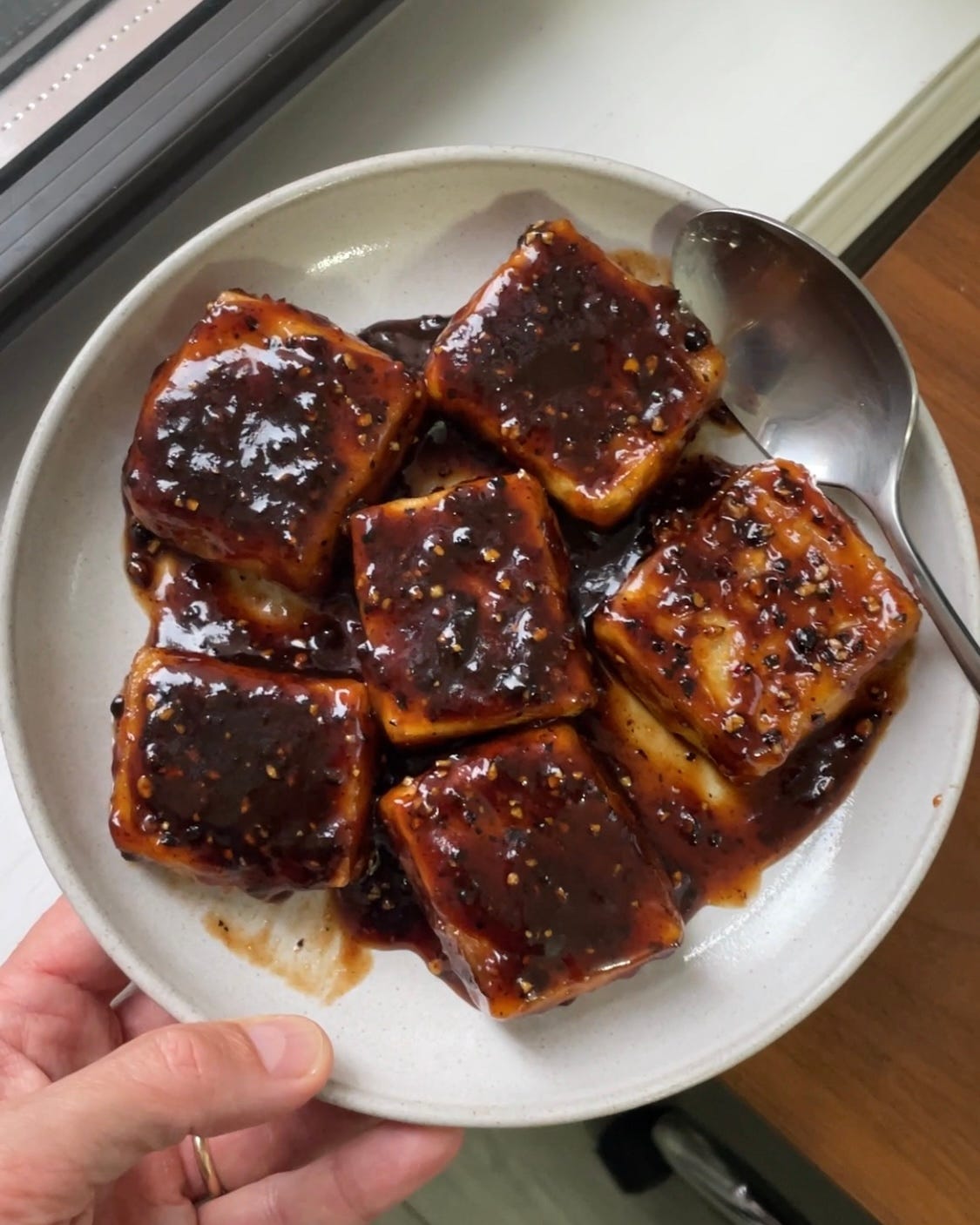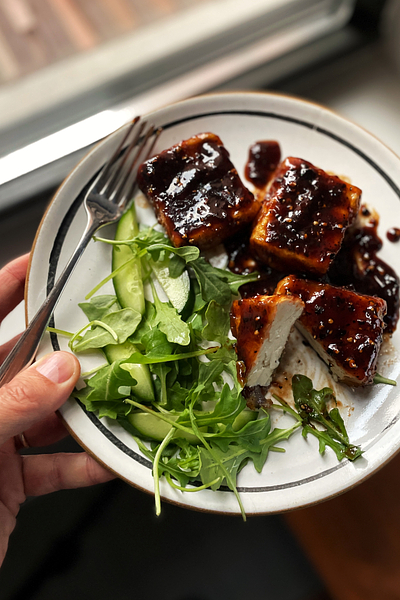Vegetarian Polish Food — Without Borders
A Q&A with author Michal Korkosz, plus a very special tofu recipe from his new book Polish'd
Note: This post includes affiliate links.
I’ve been reading a wonderful book called National Dish by Anya von Bremzen, which is not what I’m here to talk about today but I bring up because I’m engrossed with how it explores the forces — historical, political, economic — that come to define a nation’s cuisine. (If you’re interested, this Taste podcast interview is great.) But one of the big takeaways is that nationalism expressed in food is a relatively new, somewhat suspect phenomena.
I bring this up because it’s been top of mind as I’m reading and cooking from Michal Korkosz’s new cookbook Polish’d: Modern Vegetarian Cooking from Global Poland. Michal is a young, accomplished cookbook author who, as you’d guess, was born and raised in Poland. His first book, Fresh from Poland, is a favorite of mine for opening up new-to-me ways with vegetables, rooted in a cuisine I’m not very familiar with.
In Polish’d, he writes about how he was originally reluctant to embrace his native country’s cuisine — it reminded him of being bullied as a kid, and felt tied to Poland’s swelling nationalism, tinged with anti-immigrant rhetoric. And while in that first book, he sought to share Polish food traditions in a straightforward way, in Polish’d he’s taken a more expansive view, highlighting the country’s vast, longstanding, and multicultural culinary influences.
On the one hand, these recipes are a modern and vegetarian take on long-established Polish recipes, but on the other, they’re infused with flavors and ingredients brought to Poland by immigration and globalization throughout history. Some people may call this fusion, but I’d rather think of it as the natural integration of global flavors and ingredients into Polish cuisine that has come to pass over time.
It’s a subtle distinction, but I like that Michal has made it explicit — distinguishing himself from the nationalism (by its nature divisive and exclusionary) and embracing the ever-evolving reality of a culture’s food.
This isn’t to say that Polish’d is any kind of treatise — it’s a cookbook, and a very appealing and lively one, full of recipes that center vegetables in such exciting ways. It’s also a snapshot of a place in time, where old ways intermingle with new ones.
There are dumplings, dill, sauerkraut, mustard seeds, and fresh cheeses like the Polish farmer’s cheese twaróg — but also smoked tofu, miso paste, harissa, nut-and-seed based sauces, and mounds of fresh vegetables. The recipes I’ve cooked have all introduced me to something new, whether a technique, profile, or ingredient, and they’re bursting with flavor and texture.
He’s cleverly organized the book by cooking technique (steamed, fried, charred, fermented, etc) and here’s a sampling of some of the other recipes I intend to make:
Smoked Tofu Walnut Sauce
Goat Cheese Pierogi with Honey and Marjoram
Sauerkraut Bigos — a hearty stew, with Butternut Squash, Porcini, and Grapes
Fried Radishes (leaves and all!)
Sour Cream Labneh
Celeriac Schnitzel
Mashed Potatoes with Kefir
Fermented Cherry Tomatoes
And all of the dumplings
In addition to a short Q&A with Michal below, his publisher has allowed me to share this very fun recipe for Crispy Smoked Tofu with Black Polish Sauce. I was intrigued by a sauce that calls for both plum jam and a full tablespoon of black peppercorns, and I can attest that not only does it work, but it’s impossible not to enjoy. Tofu slabs are shallow-fried to create a savory, light crust and then slathered in a sticky, intensely flavorful (and bracingly peppery) glaze. You will absolutely have to try it.
And for anyone in the NYC area, Michal will be in town for a few days and has two events coming up: a Polish’d Happy Hour at Edy’s Grocer on October 25th, and a Pop-up with the Pierogi Boys from October 25th through November 1st. These are fantastic opportunities — with great small businesses here in the city — to taste Michal’s food and meet him in person.
Q&A with Michal Korkosz
What are some of the biggest misconceptions about Polish food?
I try to fight against the stereotype that Polish cuisine is meat-heavy and gray. In fact, there’s a whole array of traditional vegetarian dishes and even more exciting modern recipes based on veggies and herbs. Of course, there’re pierogi filled usually with lentils, cheeses, or vegetables, but also roasted eggplants topped with buckwheat, charred broccoli with poppyseeds and caramelized pumpkin served alongside buttered seeds and marjoram.
I love that there’s a chapter devoted to deep frying — such a thrilling, satisfying cooking method that too few home cooks even attempt. How did you decide to organize Polish’d by cooking method (raw, steamed, charred, etc)?
From the beginning, I knew that beside the layer of showing what modern Polish cuisine looks like today to me, I wanted to have a strong self-educational aspect. I really love when cookbooks give you a sense why you do what you do — a cause and effect relation. Organizing the book by cooking methods gave me an opportunity to talk about them more and stress some part of them out. I feel that Polish’d encourages you to take some parts of the recipes (techniques, tips, or flavor combinations) and adapt them to your own needs. That’s a freedom to experiment with different ways to prepare vegetables, and the demonstration of a general sense of lightness in vegetarian cooking.
One ingredient you write about in depth in both your books is cold-pressed rapeseed oil. I’d often understood rapeseed to be the basis of canola oil, which it is, but the kind you write about is a completely different ingredient. Could you tell us a bit about its place in Polish cooking, how you cook with it, and why you love it?
Rapeseed oil is indeed a very basic oil of no-flavor, usually used for deep-frying, but its cold-pressed version, often called “extra virgin olive oil of the North,” is a liquid gold! It has a very strong, enticing, nutty fragrance and tastes very herby, almost like freshly cut grass. As with most cold-pressed oils, you shouldn’t heat it too much because from one of the healthiest sources of fats, it may become carcinogenic. It’s almost always used in raw form — such as drizzling a dish like pierogi, salad, pasta, or any vegetables.
Cold-pressed rapeseed oil can be hard to find in the US. Pödör is one brand available by mail-order, or you may be able to find it if there’s a Polish grocery in your area.
You have an avowed love of dairy, and an absolutely infectious way of writing about it. Could you talk about the role of cheese and other dairy ingredients in this book? Also, what is your approach when cooking vegan meals?
I feel that we can’t talk about Polish cooking without Twaróg, farmers cheese. It’s punchy, fresh, and very healthy. It’s a taste of Poland. There’re many many other kinds of cheeses but I didn’t want to use them in Polish’d because of availability reasons. I usually use cheeses as a flavor booster. In most of the recipes you can swipe them for vegan substitutes (butter for plant butter, parmesan/szafir cheese for nutritional yeast-cashews combos, etc.), but honestly, you can often even omit them, as the flavors are strong enough!
What is Black Polish Sauce? Can you tell us a bit about the recipe in which it appears?
It’s one of the most common Polish sauces of kuchnia staropolska (Old Polish Cooking), also known as pepper sauce. It’s a very old recipe, from the sixteenth century. Not really popular these days. Traditionally it was made with plum jam, vinegar, honey, ginger, and tons of black pepper. The whole trick was in using burned straw to give the sauce its distinctive black color and also a smoky flavor. Then, it was usually served with roasted goose. When working on Polish’d, I’ve developed my version using smoked tofu and soy sauce to provide the color and umamic taste.
Find the recipe for Crispy Smoked Tofu with Black Polish Sauce below.
What excites you most right now in the world of vegetable-forward and plant-based cooking?
The whole movement of third-culture food, which creates the new styles of cooking based on the cook’s experiences. I love seeing and tasting completely new vegetarian creations of other chefs. It feels exciting and fresh!
Crispy Smoked Tofu with Black Polish Sauce
“Black Polish Sauce, often known as pepper sauce, was one of the most common and essential sauces in kuchnia staropolska (Old Polish cuisine). It was made with plum jam, vinegar, honey, and ginger, along with copious amounts of pepper. Burned straw was used to give the sauce its distinctive black color and also provided a smoky flavor. It was most often served with meat, particularly roasted goose. I’ve recreated this dish using smoked tofu and soy sauce to reproduce the color and deep taste.” — from Polish’d
I was unable to get smoked tofu (it used to be so easy to find!), so I made this from a block of firm tofu, and it worked terrifically. Michal recommends sprinkling the unsmoked tofu with liquid smoke or smoked paprika, but I left mine plain. I found that this recipe worked well with 14- to 16-ounce block, yielding enough for 3 or 4 hearty servings.
A handful of plain arugula or other baby greens and sliced cucumber pairs well as a refreshing contrast. It doesn’t even need to be dressed, since the tofu is so flavorful.
If you can’t find plum jam, apricot jam would make a good substitute.
Recipe from Polish’d: Modern Vegetarian Cooking from Global Poland [affiliate link] © Michał Korkosz, 2023. Reprinted by permission of the publisher, The Experiment. Available everywhere books are sold.
Serves 4 as a main or 2 as a side | Prep & Cooking Time 30 minutes
One 12-ounce (340 g) block firm smoked tofu (see note)
3 tablespoons cornstarch
½ teaspoon fine sea salt
½ cup (120 ml) neutral oil, such as canola or grapeseed
1 tablespoon whole peppercorns, plus more for serving
3 tablespoons plum jam
3 tablespoons soy sauce
2 tablespoons apple cider vinegar
2 tablespoons honey
One 1-inch (2.5 cm) piece fresh ginger, thinly sliced
1. Drain the tofu and press between layers of paper or kitchen towels to remove excess liquid. Repeat the process once more, and cut it into ¾-inch slices.
2. On a large plate, combine the cornstarch and salt. Dredge the tofu in the mixture to coat. Set aside.
3. Heat the oil in a large nonstick skillet over medium-high heat. The oil is ready when a pinch of bread crumbs bubbles immediately. Carefully add the tofu slices one by one so the oil doesn’t splash. Cook until crisp and brown, 3 to 4 minutes. Carefully flip and repeat on the opposite side. Reduce the heat to medium-low and remove the tofu from the skillet. Place the tofu on a plate covered with a few layers of paper or kitchen towels to drain. Discard remaining oil from the skillet.
4. Coarsely crush the peppercorns with a mortar and pestle or place in a resealable plastic bag and crush with a small saucepan. The consistency should be coarser than ground pepper.
5. In a medium bowl, combine the plum jam, soy sauce, vinegar, honey, ginger, the crushed peppercorns, and ¼ cup (60 ml) water. Transfer to the cooled skillet and bring to a boil.
6. Add the tofu. Cook, basting the tofu occasionally, until the sauce is thick enough to coat a spoon, about 3 minutes. To serve, divide among plates and top with more crushed peppercorns.









loving his cookbooks! my husband is polish and i was so pleased to share his cookbooks for Christmas:) it was such a great experience
I made this last night with some damson and grape jam. It was really good! It is somewhat reminiscent of the Ottolenghi black pepper tofu recipe that is a favourite in our house.